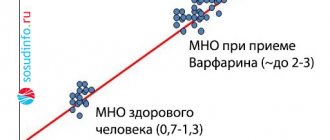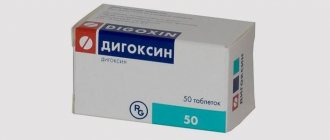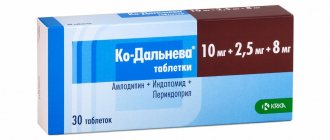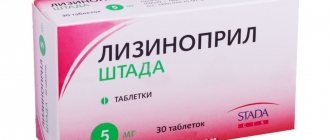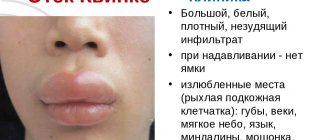Compound
Exforge tablets have active ingredients such as amlodipine and valsartan , as well as the following additional components: talc, MCC, magnesium stearate, hypromellose, colloidal silicon dioxide, titanium dioxide, crospovidone, yellow iron oxide, macrogol 4000. Co
-Exforge, in turn , has the following composition:
- active ingredients – amlodipine , valsartan , hydrochlorothiazide ;
- additional substances: MCC, colloidal silicon dioxide, hypromellose, crospovidone, macrogol, magnesium stearate, titanium dioxide, talc.
Effect on blood pressure
The active substances present in the medication stop the synthesis of excess calcium entering the blood walls. The elasticity of the arteries of the peripheral circulatory system is restored.
Due to a decrease in calcium levels, the muscle layers come into a state of complete relaxation, and therefore blood pressure not only drops to an acceptable level, but also normalizes for a long time.
The effect of the drug would not be so positive if the calcium antagonist did not inhibit angiotensin. The second active ingredient is an angiotensin-converting enzyme antagonist.
Don't tolerate high blood pressure
Now hypertension can be cured by restoring blood vessels...
>
Reducing high blood pressure does not affect the heart rate, and the selectivity of the drug leads to a visible and lasting therapeutic effect.
The biochemical process occurs with the participation of caninase, which destroys bradykinin, so inhibition and accumulation of ACE does not occur, which is why the development of a dry laryngeal cough is impossible.
The combination of common active substances with antihypertensive effects has a positive effect on:
- condition of the vascular wall;
- the patient's well-being;
- elasticity of large and small vessels;
- improving blood composition and flow.
Long-term treatment with Exforge does not affect the level of catecholamines and does not cause dependence.
Absorption of the drug occurs linearly, the active components complement each other, causing a persistent hypotonic effect. After taking the drug, a 95% connection with plasma albumin is observed, provided the stomach is “empty”, and 97% in a state of satiety.
Amlodipine and valsartan, the main components that influence the reduction of blood pressure, are subject to hepatic metabolism of 90 and 20%, respectively. The elimination period is at least 6 hours. The drug leaves the body to a greater extent through the intestines, and in small quantities through the kidneys.
The effect lasts for 24 hours or more.
Pharmacodynamics and pharmacokinetics
The active components of Exforge have a complementary mechanism of action to control blood pressure . Amlodipine belongs to the blockers of “slow” calcium channels. The second active component valsartan , is an angiotensin II receptor antagonist . The combination of these two components has a mutually complementary hypotensive effect, which causes a decrease in arterial (blood) pressure.
Amlodipine acts as a relaxant on vascular smooth muscle. It dilates the walls of blood vessels, which causes a decrease in peripheral vascular resistance and a decrease in blood pressure. With long-term use, this is not accompanied by significant changes in heart rate and catecholamine , as well as negative inotropic effects .
In people with normal left ventricular function, the drug may cause a slight increase in cardiac index without a significant effect on the rate of rise of pressure (maximum) in the left ventricle, left ventricular volume and final blood pressure.
The action of amlodipine is effective in those who have chronic stable and vasospastic angina , as well as angiographically confirmed damage to the coronary arteries .
Valsartan selectively affects AT1 receptors , blocking them, which can lead to stimulation of AT2 receptors .
With arterial hypertension , those taking valsartan experience a decrease in blood pressure without changes in heart rate . The antihypertensive effect in this case persists throughout the day. In case of heart failure (chronic) class II–IV, the number of hospitalizations decreases. In case of left ventricular failure or dysfunction of the left ventricle after myocardial infarction, a decrease in cardiovascular mortality is recorded.
The antihypertensive effect after taking the medicine becomes noticeable no later than 2 hours. The maximum reduction in blood pressure occurs after about 5 hours.
The hypotensive effect is observed for more than a day. The maximum reduction in blood pressure with repeated use can be achieved within 2-4 weeks; it remains at this level with long-term therapy. If you stop taking valsartan, there is no sharp increase in blood pressure or other undesirable consequences.
At a dosage of 10/160 mg, the drug normalizes blood pressure in most patients with inadequate blood pressure control when using amlodipine 10 mg.
When using dosages of 10/160 and 5/160 mg after using the drug, blood pressure is normalized in most patients with inadequate blood pressure control when taking valsartan 160 mg per day.
The effect of Exforge does not depend on age, race or gender.
The pharmacokinetics of this drug is characterized by linearity. After oral administration of Exforge, the maximum plasma levels of amlodipine and valsartan are achieved after approximately 7 and 3 hours, respectively.
Amlodipine is actively broken down in the liver, resulting in the formation of active metabolites . It is eliminated in two stages with a half-life of 30-50 hours. Equilibrium plasma concentrations are observed after approximately a week. 10% of the substance is excreted from the body unchanged and about 60% in the form of metabolites through the kidneys.
About 20% of the beneficial dose of valsartan is determined as metabolites . The active substance is excreted mainly unchanged through the kidneys and intestines. The half-life is about 6 hours.
The pharmacodynamics of the drug Co-Exforge, in turn, is characterized by the combined effect of three antihypertensive components, which have a complementary mechanism of action to control blood pressure . At the same time, a more significant decrease in SBP and DBP is observed when compared with the use of combinations of only two active substances included in the drug. Blood pressure targets are achieved faster.
The maximum antihypertensive effect when taking Co-Exforge can be noticed 2 weeks after the start of the course. The therapeutic effect does not depend on age, race and gender.
The maximum concentration of amlodipine , valsartan and hydrochlorothiazide after taking Co-Exforge appears after 7, 3 and 2 hours, respectively.
The bioavailability of hydrochlorothiazide when administered orally is about 70%. The half-life is 6-15 hours. The substance is excreted unchanged from the body in urine.
Instructions for use
The effect of the drug Exforge can have a negative impact on some organs and systems - the official instructions for the tablets, issued for specialists, talk about this in sufficient detail.
But not many patients are aware of the potential danger of uncontrolled use of the drug, even if they read the instructions included in the package. Meanwhile, compliance with all points from it guarantees not only the elimination of the disease, but also the elimination of the risk of complications.
Release form and composition
Exforge tablets are produced in the form of a yellow-brown color coated with an enteric-soluble film and have a round shape with a beveled edge. Outwardly, they resemble flattened dragees. The abbreviation “NVR” is printed on one side of the tablets and “NV” on the other. At the break, the tablets are painted white, sometimes with a few, very small grayish inclusions.
The tablets contain two active ingredients: amlodipine benziate and valsartan.
Their quantity in each tablet is determined by the dosage:
- 5 mg amlodipine and 80 mg valsartan;
- 5 mg amlodipine and 160 mg valsartan;
- 10 mg amlodipine and 160 mg valsartan.
The role of auxiliary (shape-forming) substances is performed by cellulose, colloidal silicon dioxide, magnesium stearate and crospovidone. The soluble shell contains the same components + polyethylene glycol, water and food coloring.
The tablets are packaged in blisters of 7 pieces each. One package of Exforge can contain 2 or 4 such blisters, that is, 14 or 28 tablets.
When purchasing tablets at a pharmacy, you need to pay attention to the dosage of each active ingredient. The most appropriate dosage for a particular patient is calculated by the attending physician. It is strictly forbidden to deviate from the recommended doses up or down.
Indications for use
Indications for the use of Exforge tablets include diseases and conditions in which the body loses the ability to independently control blood pressure levels.
These include:
- arterial hypertension;
- stable angina in chronic form;
- damage to the coronary arteries;
- vasospastic angina;
- heart failure.
Video: “Treatment of stable angina”
Mode of application
The main advantage of Exforge tablets is expressed primarily
It’s all about the convenience of taking pills. To achieve a visible therapeutic effect, it is enough to drink one tablet a day. At the same time, the absorption and severity of the effect is not affected by food intake and other parameters.
The only thing the patient needs to do is take the medicine with 150-200 ml of liquid (any liquid except alcohol).
The dosage of tablets (5/80, 5/160 or 10/160) depends on the clinical picture of the disease in a particular patient, as well as on the degree of his susceptibility to the action of amlodipine and valsartan.
Drug interactions
Exforge's list of drug interactions is not much longer than that of conventional single-drug drugs, and this despite the fact that it contains several active ingredients.
This is due to the fact that amlodipine does not enter into clinically significant reactions with drugs that are often taken together with it.
But valsartan is characterized by active interaction with certain drugs , especially those that contain potassium or contribute to its retention in the body. When taken together with Exforge, they can provoke an increase in the concentration of potassium in the urine and blood.
Contraindications
Exforge is contraindicated in case of individual intolerance to the components of the drug and pregnancy . This drug should be taken with caution in case of liver disease, mitral or aortic stenosis , hyperkalemia , hypertrophic obstructive cardiomyopathy , severe renal impairment, sodium deficiency and/or decreased volume .
Co-Exforge is contraindicated in:
- significant liver dysfunction;
- hypersensitivity to the components of the drug;
- hypokalemia , hypercalcemia , hyponatremia and hyperuricemia refractory to adequate therapy ;
- pregnancy;
- lactation;
- significant impairment of kidney function;
- childhood.
The drug should be taken with caution when:
- renal artery stenosis , as well as the artery of a single kidney, mitral or aortic stenosis ;
- decrease in BCC ;
- systemic lupus erythematosus;
- mild to moderate liver dysfunction;
- disturbances of water and electrolyte balance;
- hypertrophic obstructive cardiomyopathy ;
- diabetes mellitus.
Side effects
When taking Exforge, the following side effects are observed:
- from the respiratory system: nasopharyngitis , flu , cough, pain in the larynx and pharynx;
- from the central nervous system: paresthesia , headache , drowsiness , dizziness ;
- from the cardiovascular system: tachycardia , orthostatic hypotension , palpitations;
- skin reactions: rash, erythema ;
- from the digestive system: diarrhea / constipation , abdominal pain, dry mouth, nausea;
- from the musculoskeletal system: joint swelling, arthralgia , back pain;
- other: pastiness , peripheral edema, asthenia , flushing of the face, feeling of heat, facial swelling, increased fatigue.
In rare cases, the following were observed: increased sensitivity, visual impairment, marked decrease in blood pressure, tinnitus, anxiety , syncope, hyperhidrosis , itching, feeling of heaviness, exanthema , muscle spasms, pollakiuria , erectile dysfunction , polyuria .
In addition, side effects from each of the components may manifest themselves when consuming Exforge, even if they have not previously been observed in clinical studies.
The drug Co-Exforge has the following side effects:
- from the metabolic side: hypokalemia , anorexia , hyperlipidemia , hyponatremia , hypercalcemia ;
- from the nervous system: paresthesia , fainting , lethargy, dizziness , taste disturbances, headache , coordination problems, neuropathy ;
- from the hearing organs: vertigo ;
- from the respiratory system: cough, irritation in the throat, shortness of breath ;
- from the skin: itching, increased sweating ;
- from the kidneys and urinary tract: pollakiuria , increased plasma creatinine, renal failure ;
- general disorders: abasia , peripheral edema, increased fatigue, asthenia , pain in the chest, gait disturbances, general weakness;
- from the psyche : drowsiness , sleep disturbances;
- from the organs of vision: visual disturbances ;
- from the cardiovascular system: phlebitis , significant decrease in blood pressure, orthostatic hypotension , tachycardia , thrombophlebitis ;
- from the digestive system: dyspepsia , bad breath, abdominal discomfort, diarrhea , dry mouth, vomiting, nausea;
- from the musculoskeletal system: pain in the limbs and back, swelling of the joints, muscle spasms, muscle weakness, myalgia ;
- from the reproductive system: erectile dysfunction ;
- other: weight gain, hyperuricemia .
Exforge, 28 pcs., 10 mg+160 mg, film-coated tablets
Exforge® is a combination of 2 antihypertensive drugs with a complementary mechanism of blood pressure control: amlodipine, a dihydropyridine derivative, belongs to the class of “slow” calcium channel blockers (SCBC), valsartan belongs to the class of angiotensin II receptor antagonists. The combination of these components has a mutually complementary hypotensive effect, which leads to a more pronounced decrease in blood pressure compared to that during monotherapy with each drug.
Amlodipine
Amlodipine, which is part of the drug Exforge®, inhibits the transmembrane entry of calcium ions into cardiomyocytes and vascular smooth muscle cells. The mechanism of the antihypertensive effect of amlodipine is associated with a direct relaxing effect on vascular smooth muscle, causing a decrease in peripheral vascular resistance and a decrease in blood pressure.
When taken in therapeutic doses in patients with arterial hypertension, amlodipine causes vasodilation, leading to a decrease in blood pressure (in the patient’s “lying” and “standing” position). The decrease in blood pressure is not accompanied by a significant change in heart rate and catecholamine levels with long-term use.
Plasma concentrations of the drug correlate with clinical effect in both young and elderly patients.
In arterial hypertension in patients with normal renal function, amlodipine in therapeutic doses leads to a decrease in renal vascular resistance, an increase in glomerular filtration rate and effective renal blood flow without changing the filtration fraction and the level of proteinuria.
As with the use of other BMCCs, taking amlodipine in patients with normal left ventricular (LV) function caused changes in hemodynamic parameters of cardiac function at rest and during exercise: there was a slight increase in cardiac index without a significant effect on the maximum rate of increase in pressure in the LV (dP /dt), final dBP and LV volume. Hemodynamic studies in intact animals and humans have shown that the decrease in blood pressure under the influence of amlodipine in the range of therapeutic doses is not accompanied by a negative inotropic effect, even when used simultaneously with beta-blockers.
Amlodipine does not alter sinoatrial node function or AV conduction in intact animals and humans. When amlodipine is used in combination with beta-blockers in patients with arterial hypertension or angina pectoris, a decrease in blood pressure is not accompanied by undesirable changes in ECG parameters.
The clinical effectiveness of amlodipine has been proven in patients with chronic stable angina, vasospastic angina and angiographically confirmed lesions of the coronary arteries.
Valsartan
Valsartan is an active and specific angiotensin II receptor antagonist intended for oral administration. It acts selectively on the AT1 receptor subtype, which is responsible for the known effects of angiotensin II. An increase in plasma concentrations of free angiotensin II due to AT1 receptor blockade under the influence of valsartan may stimulate unblocked AT2 receptors, which counteract the effects of AT1 receptor blockade. Valsartan does not have any pronounced agonistic activity against AT1 receptors. The affinity of valsartan for receptors of the AT1 subtype is approximately 20,000 times higher than for receptors of the AT2 subtype.
Valsartan does not inhibit ACE, also known as kininase II, which converts angiotensin I to angiotensin II and causes the destruction of bradykinin.
When using angiotensin II antagonists, ACE inhibition and accumulation of bradykinin or substance P do not occur, so the development of a dry cough is unlikely.
In comparative clinical studies of valsartan with an ACE inhibitor, the incidence of dry cough was significantly lower (p<0.05) in patients receiving valsartan (in 2.6% of patients receiving valsartan and in 7.9% of patients receiving an ACE inhibitor). In a clinical study that included patients who had previously developed a dry cough during treatment with an ACE inhibitor, this complication was noted in 19.5% of cases during treatment with valsartan, and in 19% of cases during treatment with a thiazide diuretic. At the same time, in the group of patients treated with an ACE inhibitor, cough was observed in 68.5% of cases (p<0.05). Valsartan does not interact with or block hormone receptors or ion channels that are important for regulating the functions of the cardiovascular system.
When treating patients with arterial hypertension with valsartan, a decrease in blood pressure is observed, not accompanied by a change in heart rate.
The antihypertensive effect appears within 2 hours in most patients after a single dose of the drug. The maximum reduction in blood pressure develops within 4–6 hours. After taking the drug, the antihypertensive effect persists for more than 24 hours. With repeated use, the maximum reduction in blood pressure, regardless of the dose taken, is usually achieved within 2–4 weeks and is maintained at this level during long-term therapy. Abrupt cessation of valsartan is not accompanied by a sharp increase in blood pressure or other undesirable clinical consequences. The use of valsartan in patients with chronic heart failure (NYHA class II–IV) leads to a significant reduction in the number of hospitalizations. This effect is most pronounced in patients not receiving ACE inhibitors or beta-blockers. When taking valsartan in patients with left ventricular failure (stable clinical course) or with impaired LV function after myocardial infarction, a decrease in cardiovascular mortality is observed.
Amlodipine/Valsartan
In patients with arterial hypertension who received Exforge® once a day, the antihypertensive effect persisted for 24 hours.
The drug Exforge® in doses of 5/80 and 5/160 mg in patients with an initial SBP of 153–157 mm Hg. and dBP ≥95 and <110 mm Hg, reduces blood pressure by 20–28/14–19 mm Hg. (compared to 7–13/7–9 mmHg with placebo).
The drug Exforge® at a dose of 10/160 and 5/160 mg normalizes blood pressure (decrease in dBP in the sitting position <90 mm Hg) in 75 and 62% of patients with inadequate blood pressure control during monotherapy with valsartan at a dose of 160 mg/day. day
Exforge® at a dose of 10/160 mg normalizes blood pressure in 78% of patients with inadequate blood pressure control during monotherapy with amlodipine at a dose of 10 mg.
In patients with arterial hypertension, when combining valsartan at a dose of 160 mg with amlodipine at doses of 10 and 5 mg, an additional reduction in SBP and DBP by 6.0/4.8 mm Hg is achieved. and 3.9/2.9 mmHg. respectively, compared with patients who continued to receive valsartan 160 mg alone or amlodipine 5 and 10 mg alone.
When titrating the dose of Exforge® from 5/160 to 10/160 mg in patients with arterial hypertension with dBP ≥110 and <120 mmHg. There is a decrease in blood pressure in the sitting position by 36/29 mm Hg, comparable to a decrease in blood pressure when titrating the dose of a combination of an ACE inhibitor and a thiazide diuretic.
In two long-term studies with a long follow-up period, the effect of Exforge® was maintained for 1 year. Sudden cessation of taking Exforge® is not accompanied by a sharp increase in blood pressure.
In patients who achieved adequate blood pressure control, but developed severe edema during amlodipine monotherapy, when using combination therapy, comparable blood pressure control was achieved with a lower likelihood of developing edema.
The therapeutic effectiveness of Exforge® does not depend on the age, gender and race of the patient.
Instructions for use of Exforge
Instructions for use of Exforge include preoral use. The drug is taken once a day with some water, regardless of the time of meals. Dosages Exforge 10/160, 10/320, 5/80, 5/160, 5/320 mg. The maximum daily dose is 10/320 mg.
For those who have been prescribed Co-Exforge, the instructions for use advise using it once daily in tablets, depending on the doctor’s prescription, containing:
- 5 mg amlodipine in combination with 160 mg valsartan and 12.5 mg hydrochlorothiazide;
- 10 mg amlodipine in combination with 160 mg valsartan and 12.5 mg hydrochlorothiazide;
- 10 mg amlodipine in combination with 320 mg valsartan and 25 mg hydrochlorothiazide (2 tablets).
The tablets are taken orally regardless of meals. They must be washed down with water.
Instructions for use, price, analogues
The drug is taken once a day (1 tablet). The question of dosage - 5/80, 5/160, 10/160 - is decided by the doctor.
One of the disadvantages of this drug is its high price. On average, with a slight difference depending on the markup of pharmacies, the cost of the drug is as follows:
- 14 tablets at a dosage of 5mg/80mg – 880 rubles, 28 tablets – 1630 rubles;
- 14 tablets at a dosage of 5 mg/160 - 950 rubles, 28 tablets - 1750 rubles;
- 14 tablets at a dosage of 10 mg/160 mg – 1020 rubles, 28 tablets – 1800 rubles.
This drug also has analogues, the price of which is slightly less than that of Exforge. Analogue drugs include the following drugs:
- “Enanorm” is a combination of nitrendipine and enalapril, the average cost is about 410 rubles.
- “Amzaar” is a combination of amplodipine and losartan, costs about 600 rubles.
- "Gizaar" - a drug that contains hydrochlorothiazide and losartan, costs an average of 420 rubles.
- "Equator" - contains lisinopril and amplodipine, costs about 700 rubles.
Despite the fact that analogue drugs are much cheaper than Exforge, it must be remembered that self-medication, especially hypertension, can be dangerous to health and life. The decision to take any drug that lowers blood pressure should always be made together with your doctor, taking into account all his recommendations. Only then will it be able to provide the proper therapeutic effect and not cause harm to health.
Overdose
Valsartan in high doses can lead to a pronounced decrease in blood pressure and dizziness , and amlodipine can lead to reflex tachycardia , arterial hypotension , and excessive peripheral vasodilation .
An overdose of hydrochlorothiazide may cause symptoms associated with electrolyte loss and dehydration . The most likely manifestations: nausea, muscle spasms, cardiac arrhythmia and drowsiness .
As treatment, induce vomiting or perform gastric lavage. activated charcoal may help .
In case of arterial hypotension, the patient must take a “lying” position with his legs elevated; in addition, measures are provided to maintain the normal functioning of the cardiovascular system. To normalize blood pressure, a vasoconstrictor can be prescribed .
Interaction
Clinically significant interaction is not observed when amlodipine with thiazide diuretics, Nitroglycerin for sublingual use, ACE inhibitors, Warfarin , Sildenafil , Cimetidine , antibiotics , beta-blockers, long-acting nitrates, Digoxin , Atorvastatin , Maalox , NSAIDs, oral hypoglycemic drugs .
The combination of amlodipine with Diltiazem in elderly patients causes a slowdown in the breakdown of amlodipine, which causes an increase in its plasma content by approximately half. Together with more potent CYP3A4 inhibitors, the systemic exposure of amlodipine increases.
The combination of amlodipine with inducers of the CYP3A4 isoenzyme , on the contrary, leads to a decrease in its concentration. Therefore, its content in plasma should be monitored.
There is no clinically significant interaction when valsartan with Cimetidine, Furosemide , Atenolol , Hydrochlorothiazide , Glibenclamide , Warfarin , Digoxin , Indomethacin and Amlodipine .
It is necessary to constantly monitor the potassium concentration when simultaneous use of Exforge with dietary supplements that contain potassium-sparing diuretics , potassium and potassium-containing salt substitutes, as well as with other drugs that cause an increase in potassium levels in the blood.
When taking Co-Exforge, you should also consider the interaction of hydrochlorothiazide with other drugs. Therefore, it is necessary to monitor the use of this drug in combination with lithium preparations, hypoglycemic drugs for oral administration and insulin . Dosage adjustments may be necessary.
In addition, hydrochlorothiazide potentiates the effect of peripheral muscle relaxants, can cause an increase in the hyperglycemic effect of Diazoxide , increased sensitivity to Allopurinol , an increased risk of developing side effects of Amantadine cytotoxic drugs through the kidneys , as well as their potentiation of myelosuppressive effects . In turn, combination with NSAIDs leads to a decrease in the diuretic and antihypertensive effects of hydrochlorothiazide. Together with drugs that reduce potassium concentrations, the risk of hypokalemia . Cardiac glycosides also increase the risk of its occurrence, as well as hypomagnesemia and arrhythmia .
Together with m-anticholinergics, the bioavailability of hydrochlorothiazide increases. When combined with Methyldopa cases of hemolytic anemia , with Cyclosporine - the risk of developing hyperuricemia and the development of gout , with Cabamazepine - hyponatremia , and with vitamin D and calcium salts, an increase in calcium levels in the blood serum is likely. Cholestyramine reduces the absorption of hydrochlorothiazide.
General information about the drug
Exforge acts on blood vessels, dilating them, reducing pressure and increasing blood flow in the brain. In therapy, it is used by patients who have suffered a heart attack or stroke to prevent possible recurrences of the disease, thereby preventing hospitalization and avoiding death.
Dosage form and prices
The medicine is available in the form of tablets, which differ in the dosage of the active substance:
Tablets at a dosage of 5 mg + 80 mg are round, dark yellow, coated, marked “NVR” and “NV” on one and the other side.- Tablets 5 + 160 mg are round, dark yellow, coated and marked “NVR” and “ECE”.
- Tablets 10 + 160 mg are round, light yellow, marked with the inscriptions “NVR” and “UIC” on both sides.
The price of the drug depends on the chosen dosage and ranges from 1028 to 2089 rubles. per package.
The international nonproprietary name of the drug (INN) is Amlodipine/Valsartan.
Composition and mechanism of action
Amlodipine and valsartan are the active ingredients of the drug, their amount will differ depending on the chosen dosage. There may be 6.94 or 13.87 mg of amlodipine and 80 or 160 mg of valsartan. Additionally, they include: magnesium stearate, crospovidone, silicon dioxide, talc, titanium dioxide, red or yellow iron oxide, water and hypromellose.
The drug is taken orally, after entering the body it reaches its maximum value after 6-12 hours. Binds to proteins, is metabolized in the liver and excreted from the body by the kidneys.
With constant use of the drug, you can achieve a better effect, since the medicine has cumulative properties, and reaches its maximum effectiveness a week after starting use.
Properties
The drug is used to lower blood pressure, the effect can be recorded within two hours after taking the tablet. It will take an average of five hours to improve your well-being, and the effect will last throughout the day. The manufacturer guarantees that the patient will not notice any surges in blood pressure or pulse.
Evaluation of treatment results
Also, if necessary, you can abruptly discontinue the drug without consequences, this means that there is no withdrawal syndrome. It has also been clinically proven to significantly reduce the incidence of hospitalization or sudden cardiac arrest when taken by patients with heart failure.
How is Exforge different from Co-Exforge and Exforge N?
Exforge differs from Co-Exforge and Exforge N in its constituent components. In the last two, the substance hydrochlorothiazide is additionally used, which has a diuretic effect and is used for an additional hypotensive effect, as it removes excess fluid from the body.
Reviews of Exforge
Reviews about Exforge are both positive and negative. Many patients note its effectiveness. Some, however, say that they experienced side effects that forced them to stop taking the drug.
In fact, no specialist can rule out the occurrence of undesirable effects in advance. The drug is much more effective than taking amlodipine or valsartan alone, but its use should be well controlled. For many, in addition, it is more profitable to buy analogs of Exforge.
Reviews of Co-Exforge are generally positive. Patients note the undoubted effectiveness of this remedy and recommend it to others.
Release form and composition
The drugs are available in tablet form.
Exforge tablets have active ingredients such as amlodipine and valsartan, as well as the following additional components: talc, MCC, magnesium stearate, hypromellose, colloidal silicon dioxide, titanium dioxide, crospovidone, iron oxide yellow, macrogol 4000.
Co-Exforge, in turn, has the following composition:
- active ingredients – amlodipine, valsartan, hydrochlorothiazide (diuretic component);
- additional substances: MCC, colloidal silicon dioxide, hypromellose, crospovidone, macrogol, magnesium stearate, titanium dioxide, talc.
How is Exforge different from Co-Exforge and Exforge N?
Exforge differs from Co-Exforge and Exforge N in its constituent components. In the last two, the substance hydrochlorothiazide is additionally used, which has a diuretic effect and is used for an additional hypotensive effect, as it removes excess fluid from the body.
Exforge price, where to buy
The price of Exforge is considered quite high. You can buy this product in Moscow and other Russian cities for, on average, 1,400–1,800 rubles.
The price of Co-Exforge, on average, is about 2000 rubles.
- Online pharmacies in RussiaRussia
- Online pharmacies in KazakhstanKazakhstan
LuxPharma* special offer
- Exforge table
10 mg/160 mg No. 28 1650 rub. order - Exforge tab. 5 mg/160 mg No. 28
1600 rub. order
ZdravCity
- Exforge tablets p.p.o. 5mg+160mg 28 pcs. Novartis Pharmaceutica SA
RUB 1,892 order
- Exforge tablets p.p.o. 10mg+160mg 28 pcs. Novartis Pharmaceutica SA
1890 rub. order
- Co-exforge tab. p.p.o. 10mg+160mg+12.5mg n28 NOT DEFINED
RUB 2,265 order
- Co-exforge tab. p.p.o. 5mg+160mg+12.5mg n28 NOT DEFINED
RUR 2,268 order
- Exforge tablets p.p.o. 5mg+80mg 28 pcs. Novartis Pharmaceutica SA
RUB 1,672 order
Pharmacy Dialogue
- Exforge (tablet p/o 5mg+160mg No. 28)Novartis
RUB 2,036 order
- Exforge (tablet p/o 5mg+80mg No. 28)Novartis
RUB 1,793 order
- Exforge (tablet p/o 10mg+160mg No. 28)Novartis
RUB 2,166 order
- Co-exforge (0.005+0.16/0.0125 No. 28)Novartis
RUB 2,437 order
- Co-exforge (0.01+0.16/0.0125 No. 28)Novartis
RUB 2,426 order
show more



